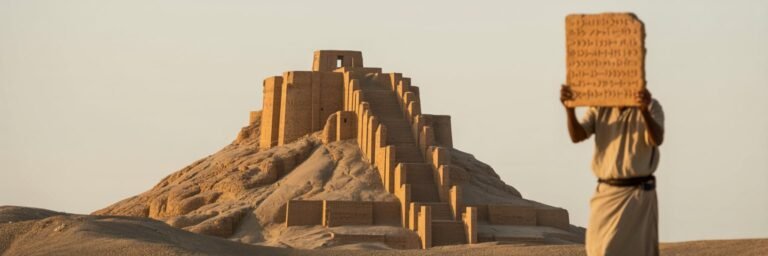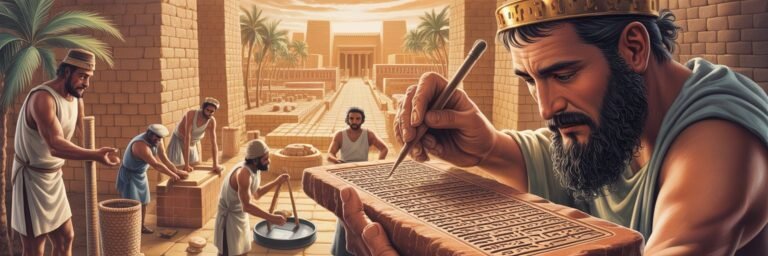INTRODUCTION
In the world of ancient civilisation, the land flanked by the Tigris and Euphrates rivers was the setting of numerous historic events, teachings, and the birth of unique cultures. This region, known as Mesopotamia—now modern-day Iraq—was home to some of the world’s first cities and empires like Sumer, Akkad, Assyria, and Babylon. Amidst the tangible artefacts, including ziggurats, sculptures, and tablets, lay the powerful echoes of spoken words from ancient times, primarily preserved in cuneiform scripts. These famous quotes, speeches, and literary texts offer us tantalizing insights into the complex world of Ancient Mesopotamia.
HISTORICAL BACKGROUND
The development of writing systems in Mesopotamia over 5000 years ago shaped the course of human communication. The cuneiform script, first used by the Sumerians around 3200 BC, granted the Sumerians, Akkadians, Babylonians, Assyrians, and Hittites alike the capability to record speeches, quotes, laws, and epics. Among the thousands of tablets that have been uncovered are works like the “Epic of Gilgamesh,” Shulgi’s hymns, and Hammurabi’s Code.
The “Epic of Gilgamesh,” an epic poem written in Akkadian, narrates the trials and tribulations of the semi-divine king Gilgamesh of Uruk. One memorable quote reads, “Only the gods live forever under the sun. As for mankind, their days are numbered, and whatever they achieve is but wind!” This profound sentiment reflects the Mesopotamians’ deep understanding and acceptance of life’s transience and mortality.
THEORIES AND INTERPRETATIONS
Analyzing ancient Mesopotamian texts isn’t straightforward. Words can be interpreted in varying ways, and context is key. Scholars often disagree about meanings and translations, leading to alternative theories. For instance, the “Epic of Gilgamesh” is interpreted as both a story of Gilgamesh’s self-discovery and lessons of leadership, camaraderie, and humility.
Another famous quotation comes from the Akkadian ruler, Naram-Sin, who declared in his Victory Stele, “Naram-Sin is powerful, he has no rival, he is a hero, his strength is unmatched.” Some scholars posit that such declarations, common in royal inscriptions, mask the leaders’ insecurities. Repeated affirmations of power might suggest their rule was questioned or threatened. Other researchers argue that these statements reflect the Mesopotamian theology, depicting leaders as divine or semi-divine entities.
MYSTERIES AND CONTROVERSIES
The rarity and fragility of cuneiform tablets leave numerous gaps in our understanding of ancient Mesopotamian culture. Intriguingly, some quotations hint at events or cultural aspects that remain elusive. For example, an inscription by Ashurbanipal, the last great king of Assyria, states, “I have read the intricate tablets of Sumer and the dark Akkadian, which are hard to understand.” This alludes to the mysteries of forgotten or lesser-known languages and texts of the time, many of which may never be deciphered due to the complexity of the cuneiform script or the lack of linguistic points of comparison.
SYMBOLISM AND CULTURAL SIGNIFICANCE
A study of famous quotes and speeches provides a glimpse into the cultural milieu of ancient Mesopotamia. For instance, the Code of Hammurabi, a Babylonian legal text, famously proclaims, “An eye for an eye, a tooth for a tooth” a phrase symbolically associated with strict justice, retribution, and societal order in Mesopotamia.
Similarly, texts often depicted the intimate relationship between Mesopotamians and their gods. In one hymn, the third dynasty ruler Shulgi sang, “O Nanna, mighty in heaven and earth – who has ever seen anything equal to it?” – testifying to their piety and dependence on divine favor.
MODERN INVESTIGATIONS
Modern archaeology and advances in technology continue to shape our understanding of these ancient cultures. New translations of texts are being undertaken, and improved imaging techniques reveal previously unreadable script fragments. Digital tools like the Cuneiform Digital Library Initiative offer unprecedented access to ancient Mesopotamian texts, fostering new scholarly discussion, theories, and interpretations.
LEGACY AND CONCLUSION
The echoes of Mesopotamian voices reverberate even today. Their words, immortalized in clay, continue to inspire, mystify, and educate. Quotes from the “Epic of Gilgamesh” still serve as a reminder of human vulnerability and need for wisdom. Hammurabi’s Code’s principles are foundational to many modern legal systems. The spiritual devotion captured in Mesopotamian hymns influenced many subsequent religions.
In conclusion, Mesopotamian quotes, speeches and literary texts are a treasure trove of wisdom and historical insight. They are gateways into a fascinating, complex world, which brought forth humanity’s first cities, empires, legal systems, and written language. Every line of cuneiform is a testament to the resilience and creativity of human civilizations, their struggles, achievements and profound understanding of life, which continue to resonate down the ages.






